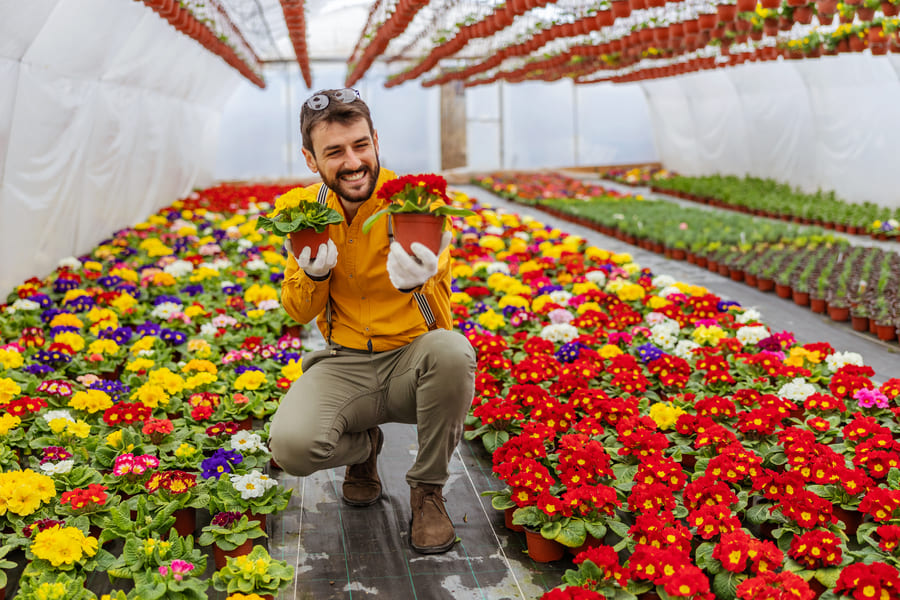Posted On: June 03, 2025
Posted By: KSNM DRIP

Drip irrigation is a game-changer for flower farming, ensuring efficient water use and healthier blooms. By delivering water directly to the roots, it prevents wastage, enhances plant growth, and improves flower quality whether growing roses or orchids, a well-planned drip system boosts productivity while conserving essential resources.
Yes, just like any other crop, drip irrigation can be used in flower farms to conserve water and produce high-quality flowers in large quantities. Using drip irrigation in your flower farm ensures that the optimal moisture level is maintained to suit the type of flower crop that you are growing.
Drip irrigation is effective in flower cultivation but it is not suitable for all flower crops. Here are some of the best flowering cash crops for which you can use a drip irrigation system,
Roses: Precise water delivery to the root zone enhances bloom size and quality while minimising fungal diseases by keeping foliage dry.
Carnations: Consistent soil moisture promotes uniform stem length and flower development, essential for market standards.
Gerberas: Controlled watering prevents waterlogging, reducing root rot incidents and ensuring vibrant, long-lasting flowers.
Anthuriums: Maintaining optimal soil moisture through drip systems supports their preference for high humidity and moist conditions, leading to improved spathe colouration.
Orchids: Drip irrigation provides the gentle, consistent moisture orchids require, closely mimicking their natural epiphytic environment.
Jasmine: Regular watering schedules enhance flowering frequency and fragrance intensity, crucial for both ornamental and industrial uses.
Dahlias: Steady moisture levels prevent tuber dehydration, promoting robust plant growth and prolific flowering.
Marigolds: Efficient water use through drip systems leads to abundant flowering and reduces the risk of soil-borne diseases.
Adopting drip irrigation in flower farming not only conserves vital resources but also enhances crop quality and operational efficiency, making it a valuable investment for sustainable agricultural practices.
Drip irrigation is highly efficient, reducing water usage by 30-50% compared to traditional methods. By applying water directly to the soil, evaporation and runoff are minimized, making it an ideal solution in water-scarce regions.
By keeping foliage dry, drip systems decrease the incidence of fungal diseases and other moisture-related issues. Consistent soil moisture levels prevent plant stress, leading to robust growth and vibrant blooms.
Drip irrigation helps in the precise application of fertilizers through fertigation, delivering nutrients directly to the root zone. This targeted approach enhances nutrient uptake efficiency, reduces leaching, and promotes healthier plants.
By limiting water distribution to specific plant areas, drip irrigation minimizes moisture in surrounding soil, inhibiting weed seed germination and growth. This results in reduced competition for resources and less labor-intensive weeding.
The efficiency of drip systems leads to lower water and fertilizer consumption, directly reducing operational costs. Additionally, healthier plants with higher yields contribute to increased profitability for flower farmers.
Drip irrigation systems can be customized to suit various flower crops and field configurations. They are effective in diverse soil types and terrains, making them versatile for different farming conditions.
Instead of buying the necessary products for drip irrigation, you can go for drip irrigation kits that come with everything you need to set up a drip irrigation system in your farmland.
Installing a drip irrigation system in your flower field is an efficient way to ensure consistent moisture delivery directly to plant roots, promoting healthier growth and conserving water. Here's a step-by-step guide to help you set up an effective drip irrigation system:
Plan the layout by sketching the field and marking plant locations and water sources to determine the best tubing routes.
Gather all necessary materials, including mainline tubing, drip lines, emitters, filters, pressure regulators, connectors, end caps, stakes, and an optional timer.
Connect the mainline tubing to the water source and include a filter and pressure regulator to maintain a clean and consistent water flow.
Lay the mainline tubing along plant rows or around bed perimeters, securing it with stakes to keep it in place.
Install the drip lines by connecting them to the mainline tubing with appropriate connectors and positioning them alongside each row of plants.
Place the emitters near the base of each plant to ensure that water reaches the root zone effectively.
Seal the ends of all tubing lines with end caps to prevent any water loss and maintain efficiency.
Test the system by turning it on to check for leaks and ensure even water distribution, making adjustments to the emitters if necessary.
If you want to know more about the installation process you can look up for it at
10 Easy Steps to Installing a Drip Irrigation System.
Drip irrigation optimizes water usage, promotes healthier plants, and enhances flower yield. Its precision watering method reduces costs and minimizes disease risks, making it a sustainable choice for flower farmers. Installing a drip system ensures consistent moisture and long-lasting blooms, offering an efficient and eco-friendly approach to flower cultivation.